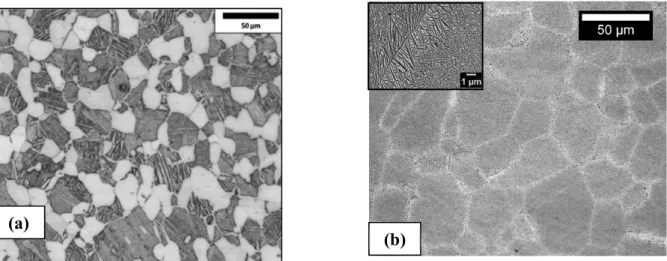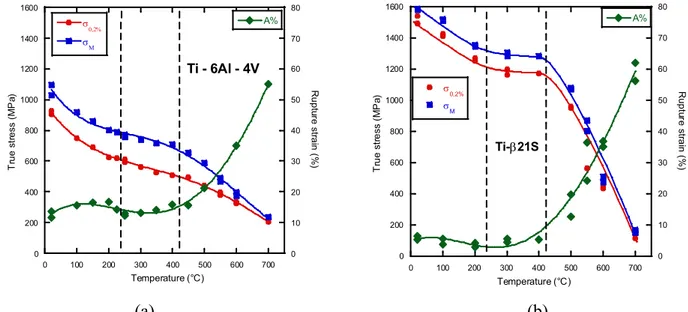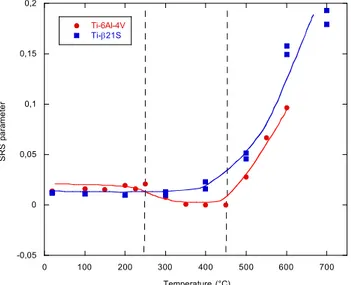HAL Id: hal-02392091
https://hal.archives-ouvertes.fr/hal-02392091
Submitted on 3 Dec 2019HAL is a multi-disciplinary open access archive for the deposit and dissemination of sci-entific research documents, whether they are pub-lished or not. The documents may come from teaching and research institutions in France or abroad, or from public or private research centers.
L’archive ouverte pluridisciplinaire HAL, est destinée au dépôt et à la diffusion de documents scientifiques de niveau recherche, publiés ou non, émanant des établissements d’enseignement et de recherche français ou étrangers, des laboratoires publics ou privés.
Low Temperature Strain Rate Sensitivity of Titanium
Alloys
Héloïse Vigié, Thalita De Paula, Martin Surand, Bernard Viguier
To cite this version:
Héloïse Vigié, Thalita De Paula, Martin Surand, Bernard Viguier. Low Temperature Strain Rate Sensitivity of Titanium Alloys. Solid State Phenomena, Trans Tech Publications Ltd 2016, 258, pp.570-573. �10.4028/www.scientific.net/SSP.258.570�. �hal-02392091�
OATAO is an open access repository that collects the work of Toulouse researchers and makes it freely available over the web where possible
Any correspondence concerning this service should be sent
to the repository administrator: tech-oatao@listes-diff.inp-toulouse.fr
This is an author’s version published in: http://oatao.univ-toulouse.fr/24495
To cite this version:
Vigié, Héloïse and Paula, Thalita de and Surand, Martin and Viguier, Bernard Low Temperature Strain Rate Sensitivity of Titanium Alloys. (2016) Solid State Phenomena, 258. 570-573. ISSN 1662-9779
Low Temperature Strain Rate Sensitivity of Titanium Alloys
Héloïse Vigié
a, Thalita De Paula
b, Martin Surand
cand Bernard Viguier
dCIRIMAT, ENSIACET-INPT Université de Toulouse,
4 allée Emile Monso – BP74233 – 31030 Toulouse Cedex 4, France
a
heloise.vigie@ensiacet.fr, b tdepaula@outlook.fr, c m.surand@gmail.com,
d
bernard.viguier@ensiacet.fr Keywords: Ti-β21S, Ti-6Al-4V, tensile testing, strain rate sensitivity
Abstract. Titanium alloys are widely used in many industrial applications such as in aeronautics
due to their combination of good mechanical properties, excellent corrosion resistance and low density. The mechanical behaviour of titanium alloys is known to exhibit a peculiar dependence on both deformation temperature and strain rate. Titanium alloys show significant room temperature creep and they are very sensitive to dwell fatigue and sustained load cracking. This behaviour is related to the viscosity of plastic deformation in titanium alloys, which can be represented by a strain rate sensitivity (SRS) parameter. The present study aims to compare the tensile behavior of two different titanium alloys, Ti-6Al-4V and β21S, which exhibit dissimilar microstructures. Results of tensile tests, performed under constant strain rate and including strain rate changes, are reported in terms of flow stress, ductility and SRS over a wide range of temperatures.
Introduction
Titanium alloys are currently used in the aerospace industry due to their good mechanical properties, excellent corrosion resistance and low density. Ti-6Al-4V is the titanium alloy most commonly used in the structural parts of airplanes and low temperature parts of turbine aircraft engines [1]. It is known to be a α + β alloy and has various microstructures depending on the thermo-mechanical treatment applied. Ti-β21S is a more recent alloy, developed by Timet USA in 1989 [2] to be used as a matrix in composite materials. It has a better creep resistance than Ti-6Al-4V [3] and it is a β metastable titanium alloy.
The mechanical behaviour of Ti-6Al-4V has been investigated by many authors [4]. The flow stress of this alloy is sensitive to the imposed strain rate [5] and as noticed for zirconium alloys [6, 7] this sensitivity depends on the temperature. The mechanical properties of the Ti-β21S versus temperature and strain rate has been less studied [8, 9]. The aim of this study is to compare the mechanical behaviour of these two alloys with different microstructures against temperature and strain rate. The mechanical properties are characterized starting from room temperature up to 700°C by means of imposed strain rate tensile testing. The strain rate sensitivity is studied by strain rate jumps during the imposed strain rate tensile tests.
Material and experimental procedure
The Ti-6Al-4V alloy is part of a hot-forged billet, with the chemical composition as given in Table 1, obtained through a three-step thermo-mechanical treatment. The first step consisted of die forging in the α + β temperature domain, just below the β-transus temperature. The last two steps consisted of heat treatments in the α + β domain. These two steps lead to the α precipitates coarsening and to the releasing the internal stresses. The final microstructure obtained is a duplex microstructure with primary α grains and α/β lamellar grains, see Fig. 1a. Both types of grains show an equiaxed shape and are roughly the same size, about 25 µm. In the lamellar grains, 2 µm wide α lamellae are separated by very thin β layers.
Table 1: Chemical composition of the Ti-6Al-4V and Ti-β21S alloys (in wt %).
Element Mo Al Nb V O Fe C N Others Ti
Ti-6Al-4V - 6.44 - 3.87 0.187 0.109 0.003 0.004 < 0.4 Balance
Ti-β21S 15 3 2.7 - 0.1 0.4 0.05 0.05 - Balance
The composition of the Ti-β21S alloy, prepared in 1.0 mm thick rolled sheets, is also given in Table 1. The sheets were provided in a solution-state and underwent a precipitation heat treatment at 538°C for 8h under vacuum. The final microstructure shows α precipitates at the grain boundaries and within β grains as presented in Fig. 1b. The size of the α precipitates is heterogeneous, exhibiting bands of coarse precipitates along the grain boundaries and a fine and homogenous α precipitation in the centre of the grains.
Figure 1: General microstructure of (a) Ti-6Al-4V and (b) Ti-β21S alloys.
An MTS 810 servo-hydraulic machine, equipped with a radiation furnace and a 100kN load cell was used for tensile testing at the imposed displacement rate. Two kinds of specimens were used for the tensile tests: cylindrical specimens with threaded heads, a gage diameter of 5 mm and a gage length of 32 mm were used for the Ti-6Al-4V alloy, while flat specimens with a gage length of 30 mm and a cross section of (7 x 1) mm2 were used for the Ti-β21S alloy. In both cases, three thermocouples were used to control the specimen temperature. They were spread over the gage length of the specimen and the temperature difference was always found to be lower than 5°C between the three thermocouples. Tensile tests were performed from 20°C to 700°C and an imposed strain rate of 1.6x10-4 s-1 for Ti-6Al-4V and 4.4x10-4 s-1 for Ti-β21S was applied. The evolution of mechanical behaviour of these alloys versus the temperature was recorded in terms of yield stress and ultimate tensile stress, expressed as true stress and the ductility of the alloy was followed by the evolution of the amount of plastic strain to rupture. In order to study the SRS of the flow stress for both alloys, another series of tensile tests were performed which included strain rate jumps during plastic deformation. The strain rate was changed from the monotonous strain rate previously mentioned to a strain rate ten times as high (approximately from about 10-4 s-1 up to 10-3 s-1). The SRS parameter was calculated for each strain rate change with the equation:
ln /ln ,
where the subscript 1 (resp. 2) refers to stress and strain rate values before (resp. after) the strain rate jump.
(a)
Results and discussion
The evolution of the tensile properties for the two alloys, the 0.2% offset plastic strain flow stress σ0.2, the ultimate tensile stress σm and the plastic strain up to rupture are plotted against the
deformation temperature in Fig. 2. The mechanical properties of the two alloys are clearly different at temperatures below 600°C. On the one hand, the strength of Ti-β21S is much higher than that of Ti-6Al-4V, e.g. at room temperature the ultimate tensile strength of the Ti-β21S alloy is close to 1600 MPa while that of Ti-6Al-4V is about 1150 MPa. On the other hand Ti-6Al-4V exhibits a plastic elongation that is at least twice that of the Ti-β21S alloy up to 400°C. The difference between the properties of the two alloys vanishes when the temperature increases; at 600°C the mechanical properties are quite similar for both alloys. It is also important to note that the tensile properties evolve as a function of the increasing temperature in a similar and non-monotonous manner for both alloys. In both cases three temperature domains are defined as indicated in the graphs of Fig. 2 and previously described in e.g. [4].
0 200 400 600 800 1000 1200 1400 1600 0 10 20 30 40 50 60 70 80 0 100 200 300 400 500 600 700 Ti - 6Al - 4V σ 0,2% σ Μ A% T ru e s tr e s s ( M P a ) Rup tu re s tra in ( % ) Temperature (°C) 0 200 400 600 800 1000 1200 1400 1600 0 10 20 30 40 50 60 70 80 0 100 200 300 400 500 600 700 Ti-β21S σ 0,2% σ M A% R u p tu re s tra in ( % ) Temperature (°C) T ru e s tr e s s ( M P a ) (a) (b)
Figure 2: Evolution of the 0.2% offset plastic strain flow stress σ0.2, the ultimate tensile stress σm
and the rupture strain versus the temperature of the Ti-6Al-4V (a) and the Ti-β21S (b). The SRS of the flow stress was measured for both alloys by means of strain rate jumps. The SRS parameter is plotted against temperature (T) in Fig. 3. As noted for the temperature dependence of the flow stress, the SRS evolution seems to be quite similar for both alloys. The variation of the m parameter versus temperature of the Ti-6Al-4V alloy confirms the existence of three temperature domains. This is less clear for the Ti-β21S alloy. However, this apparent difference must be related to the way the SRS parameter was measured. Indeed for both alloys and for T < 450°C the strain rate jumps result in a transient behaviour followed by a stabilized curve, forming a yield in stress-strain curve. For the Ti-6Al-4V the complete curve was recorded and m values were calculated from the σ2 stabilized level, leading to zero or even negative m values for 250 < T < 450°C. By
contrast, due to their limited ductility, the flat Ti-β21S specimens broke very rapidly upon strain rate changes and only the transient stress could be recorded. The recorded values of m thus remain positive, while the stabilized values would be close to zero, similar to what is measured for Ti-6Al-4V specimens.
By comparing the tensile properties of Ti-6Al-4V and Ti-β21S alloys, very different values for flow stress and ductility can be noticed. However, common trends for the evolution of flow stress versus strain rate and temperature are also present. For both alloys, it seems that three temperature domains can be defined corresponding to low (T < 250°C), intermediate (250 < T < 450°C) and high (T > 450°C) temperatures, as delineated by vertical dash lines in Figs. 2 and 3. The existence of such temperature domains has already been reported for the Ti-6Al-4V alloy [9, 10] as well as for other
alloys with hcp structure such as zirconium alloys [6, 7, 11]. These domains together with the values of SRS parameters indicate that deformation mechanisms involve dynamic strain aging (DSA) phenomenon, resulting from the interaction of the hexagonal structure dislocations with interstitial atoms such as oxygen [6, 11]. The present results thus indicate that the deformation mechanisms in the hexagonal α phase have a predominant influence on the mechanical properties of both 6Al-4V and β21S alloys. Consistently, the higher strength of β21S than that of Ti-6Al-4V may be related to a much smaller size of α phase precipitates in the Ti-β21S compared to the relatively wide α laths in Ti-6Al-4V.
Figure 3: Evolution of the strain rate sensitivity parameter versus temperature of the Ti-6Al-4V and the Ti-β21S alloys.
Summary
The evolution of the tensile properties of the Ti-6Al-4V and the Ti-β21S alloys was investigated across a wide range of temperatures. While the tensile properties, such as flow stress and ductility, are quite different for both alloys, the effect of temperature on the evolution of these properties presents common features. The evolution of tensile properties and SRS in relation to temperature leads to the definition of three temperature domains for the plastic deformation in both alloys, which are related to DSA phenomenon. These observations suggest that microscopic mechanisms controlling the plastic deformation of Ti-6Al-4V and Ti-β21S alloys present strong similarities despite their different microstructures.
References
[1] Boyer, R.R., Materials Sciences and Engineering A. 213, (1996), p. 103-114.
[2] Bania, P.J. and W.M. Parris, Oxidation resistant titanium-base alloy, U.S. Patent (1990). [3] Weiss, I. and S.L. Semiatin, Mat. Science and Engineering: A. 243 (1998), p. 46-65. [4] D. Banerjee, J.C. Williams, Acta Materialia 61 (2013) 844–879
[5] Surand, M., Viguier, B., Ruau, J. and Herny, E, MS&T 2012, vol 2, Pittsburg (2012) p 1518. [6] Ahn, J.S. and S.W. Nam, Materials Letters. 9(10), (1990), p. 413-415.
[7] Sun, I.H., S.R. Woo, and S.R. Chang, Journal of Nuclear Materials. 116, (1983), p. 314-316. [8] Fanning, J., The Minerals, Metal & Materials Society(USA). (1993), p. 397-410.
[9] Rosen, R.S., S.P. Paddon, and M.E. Kassner, Journal of Materials Engineering and Performance. 8 (3), (1999), p. 361-367.
[10] Majorell, A., S. Srivatsa, and R.C. Picu, Mat. Sc and Eng A. 326, (2002), p. 297-305. [11] Kelly, P.M. and P.D. Smith, Journal of Nuclear Materials. 46 (1), (1973), p. 23-34.
-0,05 0 0,05 0,1 0,15 0,2 0 100 200 300 400 500 600 700 Ti-6Al-4V Ti-β21S S R S pa ram e te r Temperature (°C)


